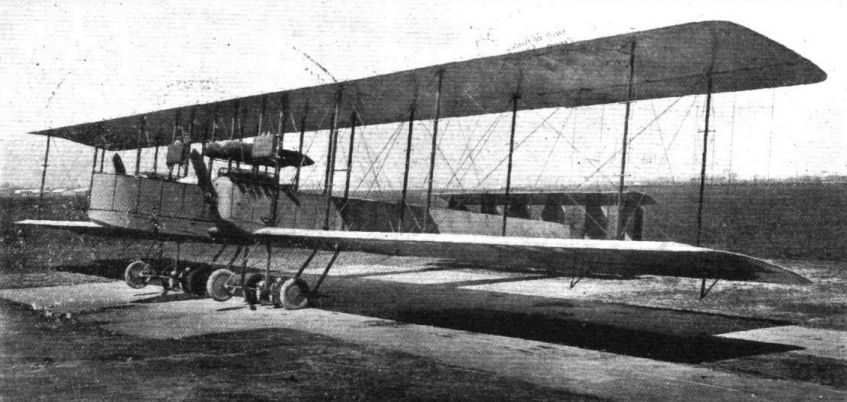
Описание
Страна: Италия
Год: 1917
J.Davilla Italian Aviation in the First World War. Vol.3: Aircraft M-W (A Centennial Perspective on Great War Airplanes 75)
SIA 14B
Inspired by the availability of the new 600-hp Fiat A.14 engine, ing. Mario Torretta designed a heavy bomber to compete with the Caproni series which had previously dominated the Italian bomber force. The new design was designated S.I.A.1200 (for 1,200 hp total engine power) but better known as the S.I.A.14. (for Fiat A.14 engines).Three examples were built in mid-1917.
The S.I.A.14b was a three bay, equal span biplane. As with the Caproni designs, there was a short central fuselage containing the crew, and two large booms with an engine in the front and a biplane tail surfaces with six fin and rudders. Beneath each of the forward bombs was a complex landing gear with 4 wheels in a row and a single wheel mounted ahead of each bogie to prevent the aircraft from nosing over; this gave a total of 10 wheels for the landing gear. Control was achieved by a servo command system. The crew was five people and defensive armament consisted of four machine guns.
Alegi has uncovered documents showing that the DGA had ordered 100 examples in August with the expectation that they were to be delivered September. It is noteworthy that not a single S.I.A.14 had yet to actually fly.
It was hoped that the new design and new engines would overcome the deficiencies of the Capronis which not only were prone to structural failures (usually the wing struts) but were also underpowered. However, it is possible that there was a growing animosity towards the Caproni firm which gave constant excuses as to why the development of new types was so slow and for their inability to meet the production schedule called for in the contracts.
Problems with the Capronis had persisted, at least partially due to poor workmanship and inadequate materials, leading to frequent breakage of the bolts connecting the wings to the interplane struts. This problem became serious enough to lead to the immediate suspension of the flight activity on January 19, 1916.
Replacing the bolts with ones made of stronger materials rectified the problems, but it took two weeks to make these modifications. As a result of these problems, Capronis at the front had to be subjected to rigorous examination after each operational flight, and new machines were subjected to equally rigorous testing prior to delivery at the front. This all called for qualified maintenance personnel, spare parts, and an adequate infrastructure.
It was planned to improve the Caproni’s range, bomb load, and defensive armament by fitting 100 examples with two 400/500-hp Fiat engines already under development at Fiat, these would be designated Ca.3s. A Caproni with three 600 hp engines was also under construction as the Ca.5. The Ca.4 would prove to be unsuited for combat operations over the front, and the Ca.5 would not enter frontline service in significant numbers until after the Armistice.
These well-laid plans would not produce a solution to the Caproni problem. The S.I.A.14 was not ready for testing until mid-November. It will never be known how much an improvement it would have offered over the Ca.4 and Ca.5, because it never completed testing. Apparently, during taxying tests the prototype was damaged. One report stated that the S.I.A. had ‘completely failed in recent tests’, although how that conclusion was made remains unclear as no S.I.A.14 had yet flown. Perhaps this refers to the extended delay in the development of the prototype (which was certainly no worse than what would happen to the Ca.4 and Ca.5) or problems with the Fiat A.14 engines.
War Minister Paolo Morrone felt that the A.14 had not failed and that it was unwarranted to conclude that it should be cancelled when it had yet to make a single flight.
It was all to no avail, the Ca.4 was selected as the new long range bomber capable of bombing Pola and Vienna, and the S.I.A.14 was shelved. The sad story of Capronis follow on designs are told in the Caproni section of this book.
S.I.A.14 bomber with two 600-hp Fiat A.14 engines
Wingspan 32.90 m.; length, 17.35 m.; height, 4.90 m; wing area, 240 sq m.
Empty weight 5.500 kg; payload, 3.000 kg; loaded weight 8.500 kgs
Maximum speed 140 km/h; ceiling 4,000 m; endurance 7 hours (these are presumably projected figures as the S.I.A.14 apparently never flew).
- J.Davilla Italian Aviation in the First World War. Vol.3: Aircraft M-W (A Centennial Perspective on Great War Airplanes 75)
Фотографии
-
Журнал - Flight за 1919 г.
One of the first giant bombing 'planes built for Italy by the S.I.A. Co., of Turin, in the early part of 1916. It had two 700 h.p. Fiat engines mounted in the forward portions of the twin fuselages. The central nacelle carried pilot, observers and bombs, the useful load being 3 tons. Span, 108 ft.; chord, 11 ft. 6 ins.; overall length, 57 ft.; and weight, empty, 5 1/2 tons
The SIA 14b remained a prototype. -
J.Davilla - Italian Aviation in the First World War. Vol.3: Aircraft M-W /Centennial Perspective/ (75)
S.I.A. 14B prototype. (Roberto Gentilli)




